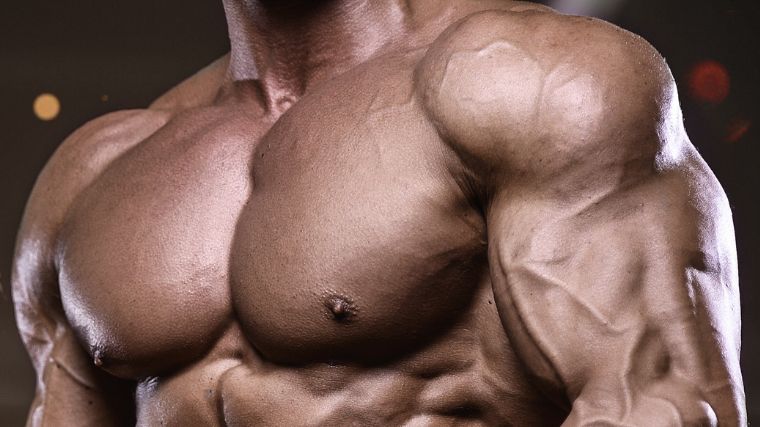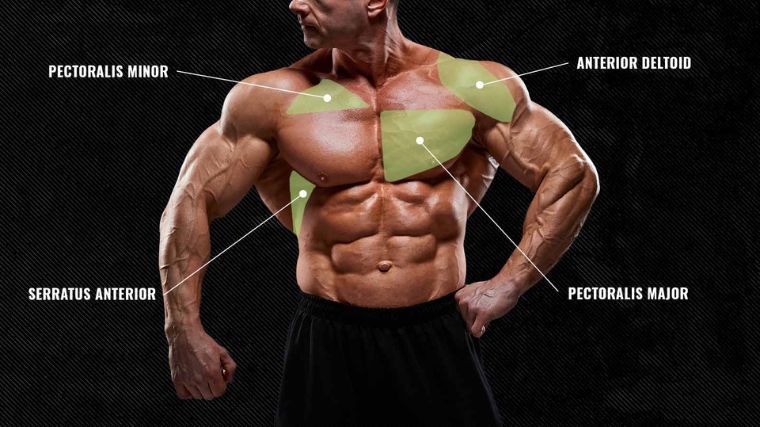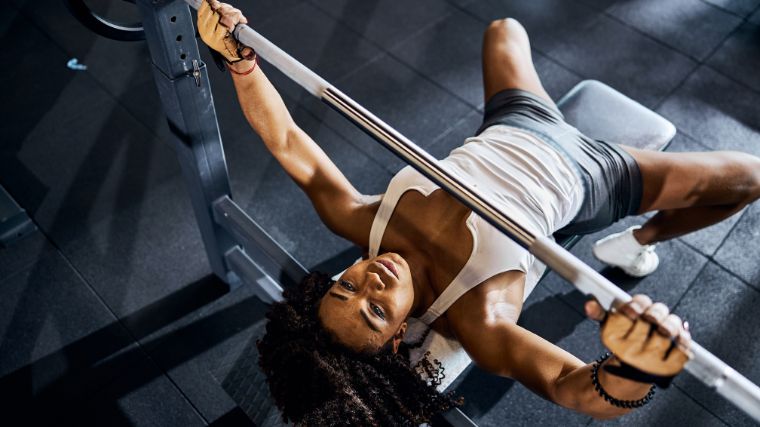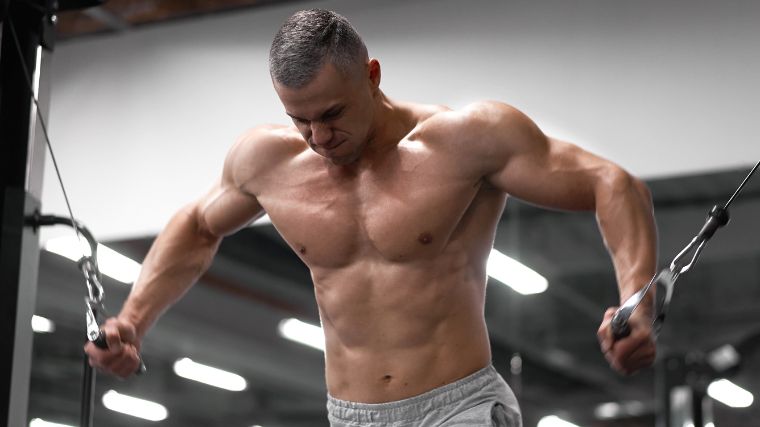There’s a reason gym rats all over the world celebrate “International Chest Day” every Monday. For physique-minded, stringer-tank-clad gym bros and “how much ya bench?” strength athletes alike, the pilgrimage from the gym doors to the bench press is as sacred a ritual as whipping up a pre-workout protein shake.
Powerful, well-developed chest muscles steal the show at bodybuilding and strength competitions alike. But building impressive pecs takes more than stubborn effort — you need a level of knowledge about your chest that’s more than skin deep.

Consider this guide to chest anatomy the answer to your prayers. This is everything you need to know about the chest muscles themselves, the principles of proper pec training, and the movements you need to plug into your workout routine before Monday.
Your Chest Muscles
To train your chest optimally, you need an understanding of your own anatomy. That is, the structure of your chest muscles and their unique functions. Your muscular system is, essentially, a series of levers and pulleys. Here’s how your chest is strung together:
Pectoralis Major
When most people think of their chests, they’re thinking of the pectoralis major. This tissue encompasses the majority of your upper anterior torso and is the prime mover of basically all chest-focused or upper-body “push” exercises.
- Where It Is: Your pec major originates in two locations — the clavicle and sternum — and inserts down onto your humerus (your upper arm bone).
- What It Does: Adducts and flexes your upper arm.
You can think of your pec major as the antagonist to your upper back. Where your back draws your arm out to the side or pulls it in toward your torso, your pecs perform the opposite function. To envision this, imagine a push-up and a bent-over row side by side.

[Read More: The Complete Guide to Pre-Workout Supplements]
Note that your pecs have two distinct compartments; the clavicular and sternocostal heads. Both are part of the pec major tissue, but canvass different portions of your upper torso. When you hear about “upper chest” training, think of the clavicular head. There is no distinct “lower chest” area in your pecs, anatomically at least, but the sternocostal fibers do run more vertically and insert closer to your abdomen.
Pectoralis Minor
Your pectoralis minor is a small, triangular muscle that sits directly underneath the clavicular fibers of your pec major. While the pec minor upholds many of the same functions as its larger, more superficial counterpart, its anatomical structure is a bit different.
- Where It Is: Originates on your upper rib cage and inserts across the edge of your shoulder blade.
- What It Does: Pulls your scapula forward and assists with general shoulder and upper arm stability.
As an assistive muscle, your pec minor works hard to stabilize your shoulder while you perform all manner of pressing movements. Exercises that require a good deal of shoulder flexion or scapular rotation, such as the incline bench press or front raise, will challenge your pec minor as well.
Other Important Muscles
While your pecs are only composed of two distinct tissues, there are a number of other muscles that assist them in action. These muscles are commonly engaged during most chest exercises you’d perform, whether as stabilizers or for producing assistive force.
Serratus Anterior
Your serratus anterior is a fan-shaped muscle that connects from your shoulder blade to your ribs like a web. Your serratus works as an auxiliary muscle during certain chest movements, particularly when you allow your shoulders to protract freely; think push-ups or flyes.
Anterior Deltoid
The front third of your shoulder muscle connects from your clavicle to your humerus. Your anterior deltoid helps to raise your arm out in front of your torso. Any time you perform a pressing exercise for your chest, your anterior deltoid will bear a portion of the load.
Best Chest Exercises
When it comes to training a muscle, your exercise options depend on the anatomical function of the tissue itself. You can’t make a muscle perform an action it isn’t designed to perform in the first place.

As such, almost all good chest-training exercises fall into one of two categories; presses and flyes. These two movement patterns cover just about everything your pecs are able to do. Here are some solid pec-building picks:
Overall — Barbell Bench Press
No one exercise can do it all, but the standard barbell bench press comes mighty close. There’s more than a few reasons why the bench press is the de facto pec-building movement.
[Related: 5 Bench Press Programs to Build a Bigger, Stronger Chest]
Bench press stations are easy to find, you can load up with seriously heavy weights and, most importantly, the barbell bench press takes your pecs through a full range of motion.
How to Do It
- Lie down on your back on a bench press station with your eyes directly underneath the barbell. Plant your feet firmly on the floor.
- Grab the bar with a medium grip (think between 1 and 1.5 times shoulder width). Inhale, then unrack the bar by pulling it horizontally out of the rack until it settles directly above your shoulders.
- Recycle your breath and brace your torso. Unlock your elbows and lower the bar down slowly until it touches your torso between your nipple line and your sternum.
- Once you make contact (or descend as low as you’re comfortably able), reverse the motion. Squeeze your chest and press the bar up and back to the starting position.
Coach’s Tip: To stabilize your shoulders and generate more force, pinch your scapulae together before you unrack the bar. Think of trying to hold a coin between your shoulder blades, and maintain that position the entire time.
Sets and Reps: Try 3 to 5 sets of 5 to 8 repetitions with a decently-challenging weight.
For Upper Chest — Close-Grip Incline Bench Press
To build a pec shelf that would make Arnold Schwarzenegger blush, you need to perform exercises that leverage the clavicular head of your pec major and your pec minor simultaneously.
In short, you need more shoulder flexion. Working on an inclined surface helps you get there. Some valuable long derm data has shown that the incline bench press may elicit more upper chest growth than flat bench variations. (1) Using a close grip should encourage more upper chest as well, but this isn’t a hard and fast rule.
How to Do It
- Sit down on a low incline bench, adjusted such that the bar is slightly behind your head. Grab the bar with a shoulder-width grip.
- Unrack the bar (or call on the assistance of a spotter if you’re lifting heavy) and settle it above your shoulders.
- Lower the weight down as far as you comfortably can, taking care to tuck your elbows as you descend.
- Reverse the motion and press the bar back up until your elbows are straight.
Coach’s Tip: It can be a bit awkward to unrack the bar for the incline bench press. Enlist a spotter if you’re lifting heavy weights.
Sets and Reps: Go for 3 to 4 sets of 6 to 8 repetitions.
For Lower Chest — High-to-Low Cable Flye
Your chest may not have a distinct lower area from an anatomical perspective, but that doesn’t mean you’re out of luck if you want to emphasize the lower portion of your pecs. Fortunately, modern scientific research is starting to come around to the idea that you can grow certain regions of a muscle through clever exercise selection. (2)
[Read More: Best Supplements for Muscle Growth]
To set your lower chest up for some real growth, try the high-to-low cable flye. This movement places your lower pec fibers in a strong, leveraged position to contract. They should bear most of the tension — and, thus, growth — here.
How to Do It
- Locate a dual cable pulley station and set the attachments at around eye level. Face away from the machine, grab each handle in the corresponding hand, and step away from the station to pull the cables taut.
- Your body and arms should resemble a “T” in the starting position. Lean forward slightly and keep your elbows mostly straight.
- Draw your arms down and inward, maintaining a straight arm the whole way until your hands come together at around waist height.
Coach’s Tip: Cables provide consistent mechanical tension to your pecs. Capitalize on that and focus hard on squeezing your chest. Some literature shows that “attentional focus” may create more muscle growth. (3)
Sets and Reps: Ante up on volume here; perform 2 to 3 sets of 12 to 15 repetitions with a moderate weight.
For Beginners — Dumbbell Bench Press
All roads lead to Rome for first-time chest trainers (Rome being gains, that is). Any exercise you perform will be effective for a time based solely on the fact that you’re new to physical training in the first place.
So, your best bet is to pick a movement like the dumbbell bench press that provides other long-term benefits. Dumbbells require you to actively stabilize the weights as you move them through space, rather than relying on the fixed path of an exercise machine. This will temporarily affect your ability to focus on your chest, but developing that stability early on is crucial for laying a strong foundation for your lifting career.
How to Do It
- Grab a pair of dumbbells and sit down on the edge of a weight bench with the weights resting on your knees, feet on the floor.
- Brace your core and sit backward. Kick lightly off the ground to propel the weights as you lie down on the bench, and straighten your arms to stabilize the weights above you.
- From here, inhale and lower the weights down toward your chest. Keep your elbows directly under your wrists.
- Once your upper arm is at least parallel to the floor, reverse the motion, pressing both up and inward slightly.
Coach’s Tip: Lower the weights down and out slightly, then press up and inward like you’re tracing a triangle with your hands.
Sets and Reps: 3 to 4 sets of 8 to 10 reps should do the trick here.
Chest Training Tips
If you strode into the gym and bee-lined toward the bench press, you’d be on track for a half decent chest workout. However, why stop at half decent? Take your chest training — and the gains that follow — up a notch by adopting these tips and principles:
Secure Your Shoulders
Your pec major may not attach directly to your shoulder joint, but your arm certainly does (not to mention your pec minor, which connects directly to the scapula). Performing presses with an unsecure shoulder position may hamper your performance or, in some cases, open you up to injury.
Professional strength athletes like powerlifters rely on a “closed,” or retracted, shoulder when they attempt a heavy bench press 1-rep max. Drawing your shoulders backward and squeezing your upper back muscles gives you a stable surface to generate force from and may protect your shoulder joints from harm as well (note that there isn’t substantive research on shoulder position and rates of injury at that joint specifically).

[Read More: Best Home Gyms]
Before you unrack your barbell or sit back to perform some dumbbell presses, actively pinch your shoulders back and lock your scapulae in place. Your shoulder needs to move freely during flye exercises and push-ups, so don’t worry about it there.
Use Different Grips
Unlike pulling exercises, your grip should never be the limiting factor during a chest workout. But that doesn’t mean you should pay no mind at all to how you hold whatever you’re working with.
While you’re warming up for your first exercise, take time to experiment with different grip styles. The bulldog grip is a great option for maintaining joint alignment; you may even try a reverse-grip bench press to emphasize your upper chest and put a new spin on the standard bench press.
Trust Your Spotter
Certain exercises, like the deadlift, have no practical use for a spotter in most cases. After all, if the weight is too heavy for you to lift, it simply won’t budge off the floor. This isn’t the case during heavy chest training, though: if you find yourself at the brink of exhaustion, the weight you’re lifting is liable to come crashing down on you.
[Read More: The Best Online Workout Programs For Coaching, Cardio, Value, And More]
If you’re going heavy on a chest workout, it is extremely wise to recruit the assistance of a good spotter. Not only will they provide a safeguard against accidents, spotters can also help you make better gains by providing some light assistance during forced reps or giving you the encouragement you need to make it through a three-round drop set.
Press With Weights, Flye With Machines
Some movement patterns are better suited to particular pieces of equipment than others. Usually, this limitation is the result of having to work around (or, more accurately, under) the resistance provided by gravity.
Gravity only applies downward force. When you’re performing a barbell bench press, this isn’t much of an issue, since you’re moving the weight almost exclusively vertically. However, there’s a good deal of horizontal movement during an exercise like the dumbbell flye.
This alters the resistance curve of the exercise. You’ll find that dumbbell flyes are very hard at the bottom, and very easy at the top, because the resistance (the dumbbell) is directly above your pecs as they contract. Most flye movements are better suited for cables or machines, which apply consistent tension from start to finish. This isn’t a hard rule, of course, but it can help you squeeze a bit more juice out of your workout.

[Read More: Build a Titanic Torso with These Bodybuilding Chest & Back Workouts]
For example, a solid bodybuilding chest workout that makes use of multiple types of equipment might look like this:
- Barbell Bench Press: 3 x 6
- Incline Dumbbell Bench Press: 3 x 8
- Cable or Machine Flye: 2 x 12
- Diamond Push-Up: 1 x AMRAP
Your Takeaways
In many ways, your chest muscles are the first impression anyone gets of your physique. They occupy valuable real estate on the front of your torso and, for athletes, are integral to strength performance.
- Your pecs are composed of two individual muscles, the pectoralis major and pectoralis minor.
- The pec major has two distinct heads which can impact exercise selection; the clavicular head (and your pec minor) make up the “upper chest.” There is no lower chest, anatomically speaking.
- Your chest primarily performs two distinct movement patterns; presses, which combine arm flexion and adduction, and flyes, which require shoulder adduction exclusively.
- Most exercises that involve pushing a weight outward away from your body will work your chest to some degree.
- A good chest workout consists of both pressing and flye exercises, usually in that order.
More Training Content
- The Anatomy of Your Back Muscles, Explained
- Bodybuilding Lore: Can You Actually Target Your Inner Chest?
- The Bodybuilder’s Guide to Transitioning From a Cut to a Bulk
References
- Chaves, S. F. N., Rocha-JÚnior, V. A., EncarnaÇÃo, I. G. A., Martins-Costa, H. C., Freitas, E. D. S., Coelho, D. B., Franco, F. S. C., Loenneke, J. P., Bottaro, M., & Ferreira-JÚnior, J. B. (2020). Effects of Horizontal and Incline Bench Press on Neuromuscular Adaptations in Untrained Young Men. International journal of exercise science, 13(6), 859–872.
- Zabaleta-Korta, A., Fernández-Peña, E., Torres-Unda, J., Garbisu-Hualde, A., & Santos-Concejero, J. (2021). The role of exercise selection in regional Muscle Hypertrophy: A randomized controlled trial. Journal of sports sciences, 39(20), 2298–2304.
- Schoenfeld, B. J., Vigotsky, A., Contreras, B., Golden, S., Alto, A., Larson, R., Winkelman, N., & Paoli, A. (2018). Differential effects of attentional focus strategies during long-term resistance training. European journal of sport science, 18(5), 705–712.
Feature Image: nazarovsergey / Shutterstock